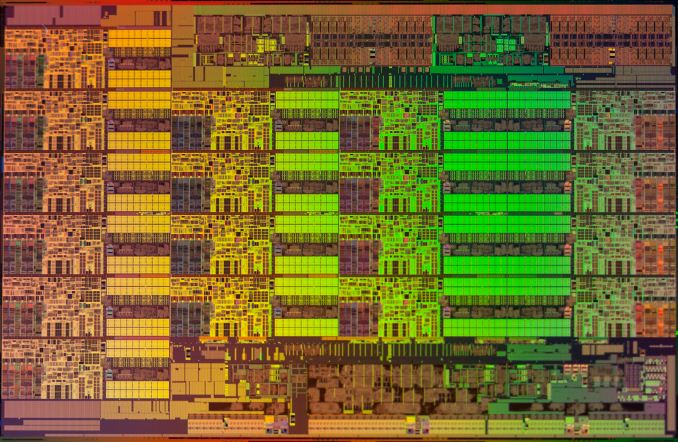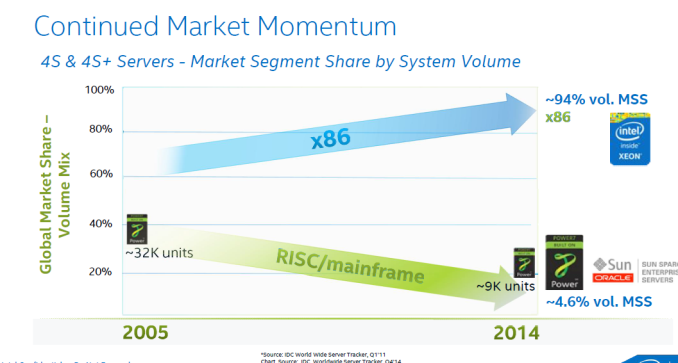The Intel Xeon E7-8800 v3 Review: The POWER8 Killer?
by Johan De Gelas on May 8, 2015 8:00 AM EST- Posted in
- CPUs
- IT Computing
- Intel
- Xeon
- Haswell
- Enterprise
- server
- Enterprise CPUs
- POWER
- POWER8

The story behind the high-end Xeon E7 has been an uninterrupted triumphal march for the past 5 years: Intel's most expensive Xeon beats Oracle servers - which cost a magnitude more - silly, and offers much better performance per watt/dollar than the massive IBM POWER servers. Each time a new generation of quad/octal socket Xeons is born, Intel increases the core count, RAS features, and performance per core while charging more for the top SKUs. Each time that price increases is justified, as the total cost of a similar RISC server is a factor more than an Xeon E7 server. From the Intel side, this new generation based upon the Haswell core is no different: more cores (18 vs 15), better RAS, slightly more performance per core and ... higher prices.
However, before you close this tab of your browser, know that even this high-end market is getting (more) exciting. Yes, Intel is correct in that the market momentum is still very much in favor of themselves and thus x86.
No less than 98% of the server shipments have been "Intel inside". No less than 92-94% of the four socket and higher servers contain Intel Xeons. From the revenue side, the RISC based systems are still good for slightly less than 20% of the $49 Billion (per year) server market*. Oracle still commands about 4% (+/- $2 Billion), but has been in a steady decline. IBM's POWER based servers are good for about 12-15% (including mainframes) or $6-7 Billion depending on who you ask (*).
It is however not game over (yet?) for IBM. The big news of the past months is that IBM has sold its x86 server division to Lenovo. As a result, Big Blue finally throw its enormous weight behind the homegrown POWER chips. Instead of a confusing and half heartly "we will sell you x86 and Itanium too" message, we now get the "time to switch over to OpenPOWER" message. IBM spent $1 billion to encourage ISVs to port x86-linux applications to the Power Linux platform. IBM also opened up its hardware: since late 2013, the OpenPower Foundation has been growing quickly with Wistron (ODM), Tyan and Google building hardware on top of the Power chips. The OpenPOWER Foundation now has 113 members, and lots of OpenPower servers are being designed and build. Timothy Green of the Motley fool believes OpenPower will threaten Intel's server hegemony in the largest server market, China.
But enough of that. This is Anandtech, and here we quantify claims instead of just rambling about changing markets. What has Intel cooked up and how does it stack up to the competion? Let's find out.
(*) Source: IDC Worldwide Quarterly Server Tracker, 2014Q1, May 2014, Vendor Revenue Share











146 Comments
View All Comments
Dmcq - Saturday, May 9, 2015 - link
Well they'll sell where performance is an absolute must but they won't pose a problem to Intel as they won't take a large part of the market and they'd keep prices high. I see the main danger to Intel being in 64 bit ARMs eating the server market from below. I suppose one could have cheap and low power POWER machines to attack the main market but somehow it just seems unlikely with their background.Guest8 - Saturday, May 9, 2015 - link
Uh did you see Anandtech's reviews on the latest ARM server? The thing barely keeps up with an Avoton. Intel is well aware of ARM based servers and has preemptively disARMed the threat. If ARM could ever deliver Xeon class performance it would look like Power8.melgross - Saturday, May 9, 2015 - link
Chip TDP is mostly a concern for the chip itself. Other areas contribute far more waste heat than the CPU does.PowerTrumps - Saturday, May 9, 2015 - link
Power doesn't need to have a TDP of 1000W but 200W is nothing given the performance and efficiency advantage of the processors and Power hypervisor. When you can consolidate 2, 4 and 10 2 socket Intel servers into 1 x 2 socket Power8 server that is 10 x 2 x 135W = 2700 overall Watts vs 400W with the Power server. Power reduces the overall energy, cooling and rack space consumption.KAlmquist - Saturday, May 9, 2015 - link
$4115 E5-2699 (18C, 2.3 Ghz (3.6 Ghz turbo), max memory 768 GB)$5896 E7-8880 (18C, 2.3 Ghz (3.1 Ghz turbo), max memory 1536 GB)
That's a big premium for the E7--enough that it probably doesn't make sense to buy an 8 socket system just to run a bunch of applications in parallel. The E7 makes sense only if you need more than 36 cores to have access to the same memory.
PowerTrumps - Saturday, May 9, 2015 - link
I really enjoyed the article as well as the many data and comparison charts. It is unfortunate that most of your statements, assessments and comparisons about Power and with Intel to Power were either wrong, misleading, not fully explained or out of context. I invite the author to contact me and I will be happy to walk you through all of this so you can update this article as well as consider a future article that shows the true advantage Power8 and OpenPower truly has in the data center and the greater value available to customers.KAlmquist - Saturday, May 9, 2015 - link
I would be surprised if anybody working for Anandtech is going to contact an anonymous commentator. You can point out portions of the article that you think are wrong or misleading in this comment section.To do a really good article on Power8, Anandtech needs a vendor to give Anandtech access to a system to review.
PowerTrumps - Sunday, May 10, 2015 - link
Admittedly I assumed when I registered for the PowerTrumps account some time ago I used a email address which they could look up. But, your point is taken. Brett Murphy with Software Information Systems (aka SIS) www.thinksis.com. Email at bmurphy@thinksis.com. If I pointed out all of the mistakes my comment would look like a blog which many don't appreciate. I have my own blog for that. I like well written articles and happy to accept criticism or shortcomings with IBM Power - just use accurate data and not misrepresent anything. Before Anandtech reviews a Power8 server, my assessment is they need to understand what makes Power tick and how it is different than Intel or SPARC for that matter. Hope they contact me.thunng8 - Sunday, May 10, 2015 - link
I too would like a more detailed review of the Power8.Some of the text in the article made me laugh on how wrong they are.
For example, the great surprise that Intel is not on top.. Well anandtech has never test any Power systems before..
And it is laughable to make any conclusions based on running of 7zip. Just about any serious enterprise server benchmark shows a greater than 2x performance advantage per core in favor of Power compared to the best Xeons. So that 50% advantage is way less than expected.
Btw Power7 for most of its life bested Xeon in performance by very large margins. It is just now that IBM have opened up Power to other vendor that makes it exciting.
JohanAnandtech - Monday, May 11, 2015 - link
I welcome constructive critism. And yes, we only had access to an IBM Power8 dev machine, so we only got a small part of the machine (1 core/2GB)."Some of the text in the article made me laugh on how wrong they are."
That is pretty low. Without any pointer or argument, nobody can check your claims. Please state your concerns or mail me.